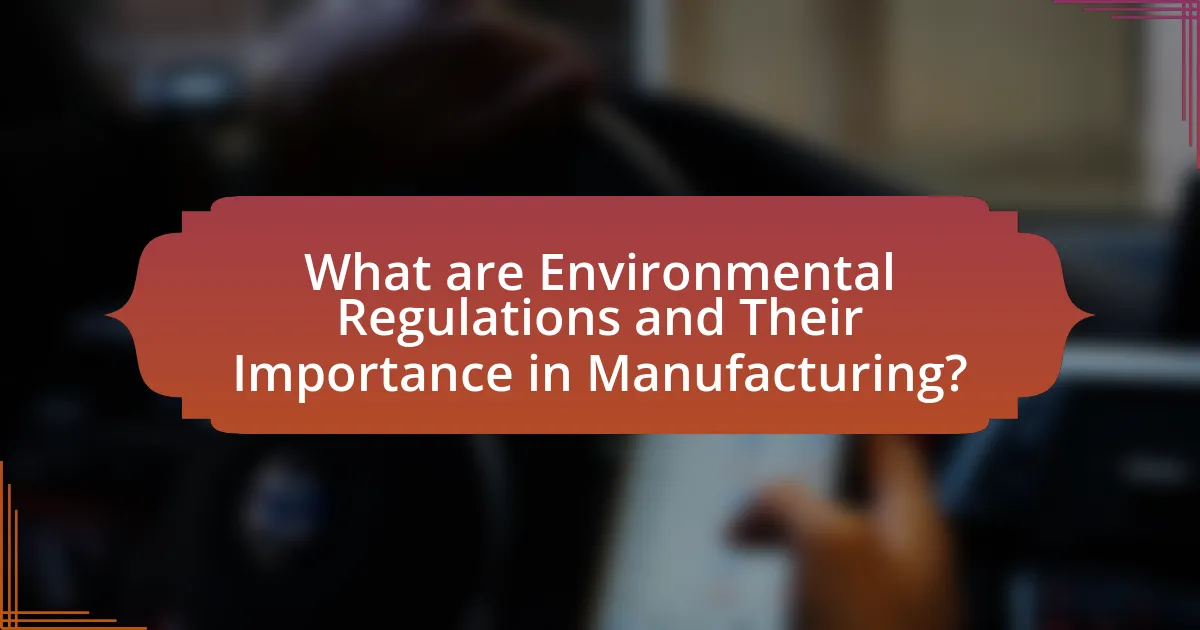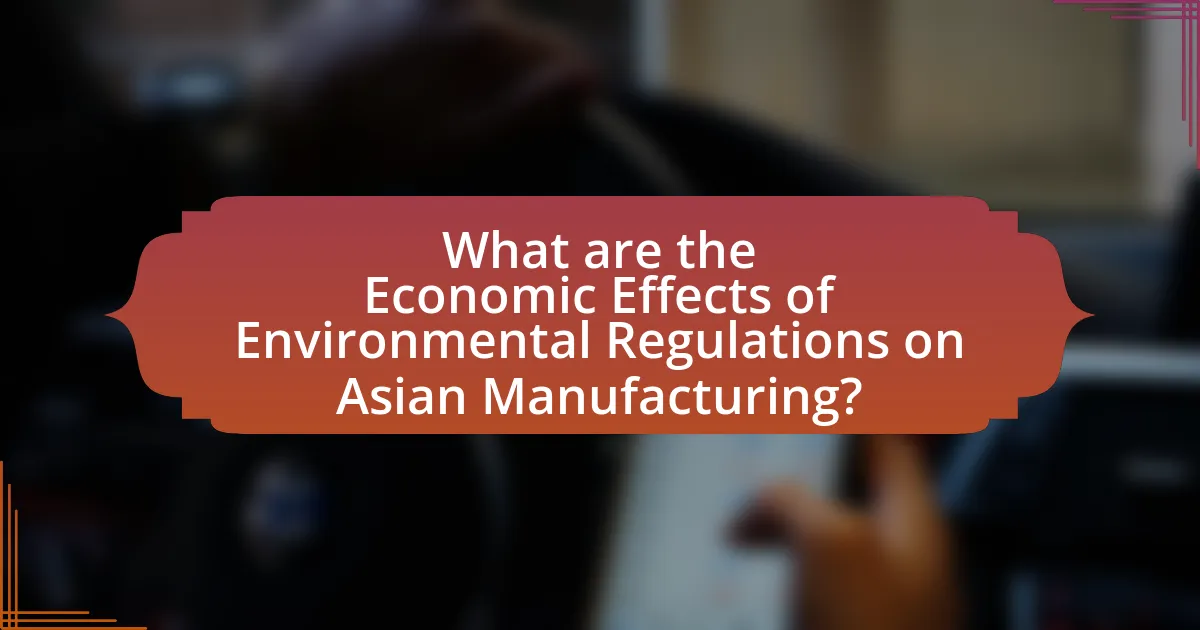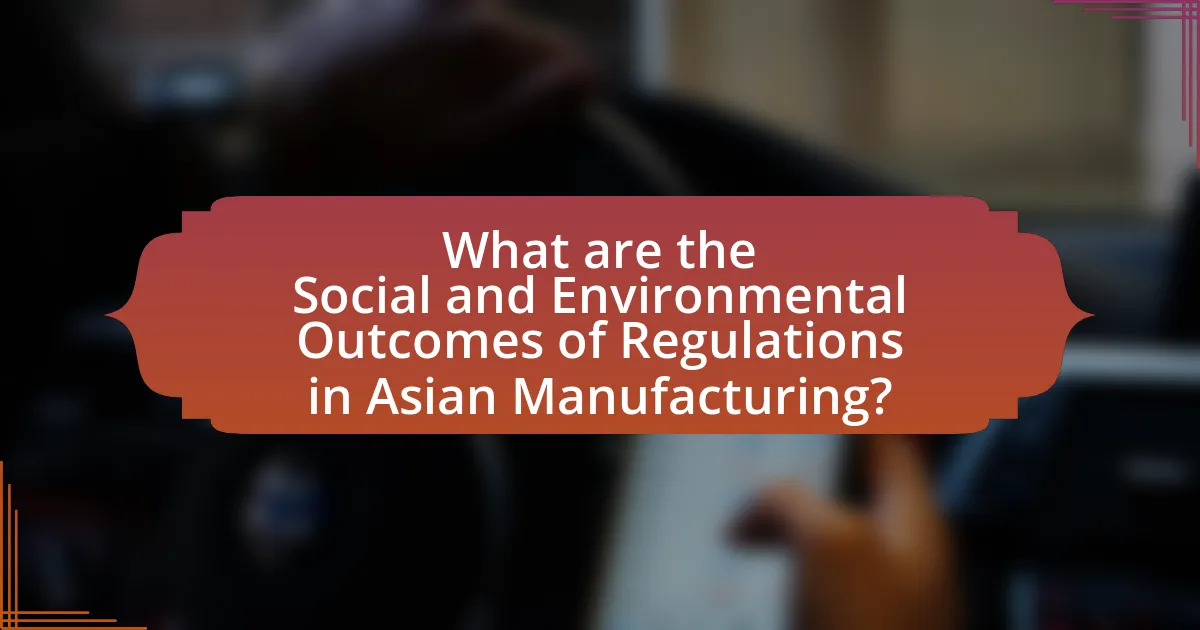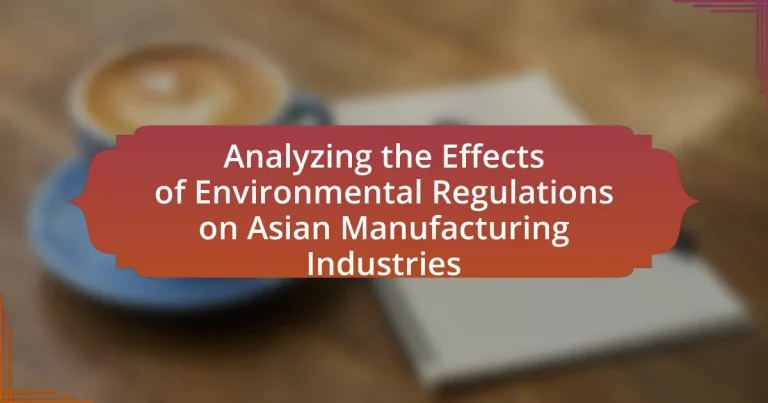Environmental regulations are laws and standards established by governments to mitigate the environmental impact of manufacturing activities, playing a crucial role in promoting sustainable practices within the sector. This article analyzes the effects of these regulations on Asian manufacturing industries, highlighting their impact on operational costs, technological innovation, and compliance challenges. It discusses specific regulations enforced across various Asian countries, the economic implications for local versus international firms, and the social and environmental outcomes resulting from adherence to these regulations. Additionally, the article examines best practices that manufacturers can adopt to ensure compliance while enhancing competitiveness and sustainability.

What are Environmental Regulations and Their Importance in Manufacturing?
Environmental regulations are laws and standards established by governments to control the environmental impact of manufacturing activities. These regulations are crucial in manufacturing as they ensure that companies minimize pollution, manage waste responsibly, and use resources sustainably. For instance, the Clean Air Act in the United States mandates reductions in air pollutants, which has led to significant improvements in air quality and public health. Compliance with these regulations not only protects the environment but also enhances a company’s reputation, reduces liability risks, and can lead to cost savings through improved efficiency and waste reduction.
How do environmental regulations impact manufacturing industries in Asia?
Environmental regulations significantly impact manufacturing industries in Asia by increasing operational costs and driving technological innovation. These regulations often require manufacturers to invest in cleaner technologies and processes to comply with stricter emissions standards, which can lead to higher production costs. For instance, a study by the Asian Development Bank found that compliance with environmental regulations can increase costs by 10-20% for certain industries, such as textiles and chemicals. However, these regulations also incentivize companies to adopt sustainable practices, leading to long-term benefits such as improved efficiency and reduced waste. Consequently, while the immediate financial burden may be substantial, the overall effect can foster a more sustainable manufacturing sector in the region.
What specific regulations are commonly enforced in Asian manufacturing?
Commonly enforced regulations in Asian manufacturing include environmental standards, labor laws, and safety regulations. Environmental regulations often focus on emissions control, waste management, and resource conservation, with specific frameworks like the Clean Air Act in countries such as China and India. Labor laws typically enforce minimum wage, working hours, and conditions, as seen in the International Labour Organization’s guidelines adopted by various Asian nations. Safety regulations mandate compliance with occupational health and safety standards, which are critical in industries like textiles and electronics. These regulations aim to ensure sustainable practices, protect workers, and promote safe working environments, reflecting the increasing global emphasis on corporate responsibility and environmental stewardship.
How do these regulations vary across different Asian countries?
Environmental regulations vary significantly across different Asian countries, influenced by economic development, political frameworks, and environmental priorities. For instance, countries like Japan and South Korea have stringent regulations focusing on pollution control and sustainable practices, supported by advanced technology and enforcement mechanisms. In contrast, countries such as India and Vietnam have less stringent regulations, often prioritizing economic growth over environmental protection, leading to higher levels of industrial pollution. According to the World Bank, as of 2021, Japan ranked 1st in environmental performance among Asian countries, while India ranked 177th, highlighting the disparity in regulatory frameworks and enforcement. This variation affects the manufacturing industries’ compliance costs and operational practices across the region.
Why are environmental regulations necessary for sustainable manufacturing?
Environmental regulations are necessary for sustainable manufacturing because they ensure that production processes minimize harm to the environment and promote resource efficiency. These regulations compel manufacturers to adopt cleaner technologies and practices, which can lead to reduced emissions, waste, and resource consumption. For instance, the implementation of the ISO 14001 standard has been shown to improve environmental performance in manufacturing sectors by requiring organizations to systematically manage their environmental responsibilities. Additionally, studies indicate that companies adhering to stringent environmental regulations often experience long-term cost savings and enhanced competitiveness, as they are better positioned to meet consumer demand for sustainable products.
What are the environmental challenges faced by Asian manufacturing industries?
Asian manufacturing industries face significant environmental challenges, including air and water pollution, waste management issues, and resource depletion. Air pollution is primarily caused by emissions from factories, which contribute to health problems and environmental degradation; for instance, the World Bank reported that air pollution in Asia leads to millions of premature deaths annually. Water pollution arises from industrial discharges that contaminate local water sources, affecting both ecosystems and human health; a study by the Asian Development Bank highlighted that industrial wastewater is a major contributor to water quality deterioration in the region. Additionally, the over-extraction of natural resources, such as minerals and timber, leads to habitat destruction and biodiversity loss, as noted in various environmental assessments. These challenges are exacerbated by inadequate regulatory frameworks and enforcement, making it difficult for industries to adopt sustainable practices.
How do regulations help mitigate these environmental challenges?
Regulations help mitigate environmental challenges by establishing legally binding standards that limit pollution and resource depletion in manufacturing industries. These standards compel companies to adopt cleaner technologies and practices, thereby reducing emissions and waste. For instance, the implementation of the Clean Air Act in the United States led to a 70% reduction in air pollutants from industrial sources between 1970 and 2019, demonstrating the effectiveness of regulatory frameworks in improving environmental quality. Additionally, regulations often include penalties for non-compliance, incentivizing manufacturers to adhere to environmental guidelines, which further contributes to sustainable practices.

What are the Economic Effects of Environmental Regulations on Asian Manufacturing?
Environmental regulations significantly impact Asian manufacturing by increasing operational costs and influencing competitiveness. These regulations often require manufacturers to invest in cleaner technologies and processes, which can raise production expenses. For instance, a study by the Asian Development Bank found that compliance with stricter environmental standards can lead to a 10-20% increase in manufacturing costs. However, these regulations can also drive innovation and efficiency, as companies seek to reduce waste and improve resource management. Additionally, firms that adapt successfully may gain a competitive edge in global markets increasingly favoring sustainable practices.
How do environmental regulations influence production costs in manufacturing?
Environmental regulations increase production costs in manufacturing by imposing compliance expenses and operational adjustments. Manufacturers must invest in cleaner technologies, waste management systems, and employee training to meet regulatory standards, which can lead to higher initial capital expenditures. For instance, a study by the World Bank found that compliance with environmental regulations can raise production costs by 2% to 5% in developing countries. Additionally, ongoing costs related to monitoring and reporting can further strain budgets, impacting overall profitability.
What are the short-term economic impacts of compliance with these regulations?
Compliance with environmental regulations in Asian manufacturing industries typically results in increased operational costs in the short term. These costs arise from investments in cleaner technologies, employee training, and compliance monitoring systems. For instance, a study by the Asian Development Bank found that manufacturers often face a 10-20% increase in production costs due to the need for upgraded equipment and processes to meet regulatory standards. Additionally, companies may experience temporary disruptions in production as they adapt to new compliance requirements, which can lead to reduced output and lower profit margins in the immediate term.
How do regulations affect long-term profitability in manufacturing sectors?
Regulations significantly impact long-term profitability in manufacturing sectors by imposing compliance costs and influencing operational efficiencies. Compliance with environmental regulations often requires manufacturers to invest in cleaner technologies and processes, which can initially increase operational costs. However, these investments can lead to improved efficiencies and reduced waste over time, ultimately enhancing profitability. For instance, a study by the World Bank found that firms adhering to stricter environmental standards often experience lower operational costs in the long run due to reduced resource consumption and waste management expenses. Additionally, regulations can create a competitive advantage for compliant firms by fostering innovation and improving brand reputation, which can attract more customers and increase market share.
What are the implications for competitiveness among Asian manufacturers?
The implications for competitiveness among Asian manufacturers are significant, as stricter environmental regulations can lead to increased operational costs and necessitate investment in cleaner technologies. These regulations compel manufacturers to innovate and adopt sustainable practices, which can enhance their market position by appealing to environmentally conscious consumers. For instance, a study by the Asian Development Bank in 2021 highlighted that manufacturers who proactively comply with environmental standards can gain a competitive edge through improved efficiency and reduced waste. Consequently, while the initial financial burden may be high, the long-term benefits include enhanced brand reputation and access to new markets that prioritize sustainability.
How do regulations impact the market position of local versus international firms?
Regulations significantly influence the market position of local versus international firms by creating varying compliance costs and competitive advantages. Local firms often face stricter regulations tailored to domestic standards, which can increase operational costs and limit their market flexibility. In contrast, international firms may benefit from economies of scale and resources that allow them to absorb regulatory costs more effectively, thus maintaining competitive pricing. For instance, a study by the Asian Development Bank found that local manufacturers in Southeast Asia experienced a 20% increase in compliance costs due to environmental regulations, while international firms could leverage their global supply chains to mitigate these costs. This disparity can lead to a market environment where local firms struggle to compete, ultimately affecting their market share and sustainability.
What strategies can manufacturers adopt to remain competitive under strict regulations?
Manufacturers can adopt strategies such as investing in sustainable technologies, enhancing operational efficiency, and engaging in proactive compliance management to remain competitive under strict regulations. Investing in sustainable technologies, such as energy-efficient machinery and waste reduction systems, not only helps meet regulatory standards but also reduces operational costs over time. Enhancing operational efficiency through lean manufacturing practices can minimize waste and improve productivity, allowing manufacturers to maintain profitability despite regulatory pressures. Proactive compliance management, which includes staying updated on regulatory changes and implementing best practices, ensures that manufacturers avoid penalties and can adapt quickly to new requirements. These strategies have been shown to improve competitiveness in various industries, as evidenced by a study from the World Bank indicating that firms adopting green technologies can achieve up to 20% cost savings in the long run.

What are the Social and Environmental Outcomes of Regulations in Asian Manufacturing?
Regulations in Asian manufacturing lead to improved social and environmental outcomes, including enhanced worker safety, reduced pollution, and increased sustainability practices. For instance, stricter environmental regulations have prompted manufacturers to adopt cleaner technologies, resulting in a significant decrease in air and water pollutants. A study by the Asian Development Bank found that countries implementing stringent environmental policies saw a 30% reduction in industrial emissions over a decade. Additionally, these regulations often improve labor conditions, as companies are required to adhere to safety standards, thereby reducing workplace accidents and fostering a healthier workforce.
How do environmental regulations affect labor practices in manufacturing industries?
Environmental regulations significantly influence labor practices in manufacturing industries by imposing standards that ensure worker safety and environmental protection. These regulations often require manufacturers to adopt cleaner technologies and safer working conditions, which can lead to improved labor practices. For instance, compliance with regulations such as the Occupational Safety and Health Administration (OSHA) standards in the United States has been shown to reduce workplace injuries and illnesses, thereby enhancing overall labor conditions. Additionally, adherence to environmental regulations can foster a culture of responsibility and accountability among workers, as they become more aware of the environmental impacts of their work. This shift not only improves labor practices but can also enhance employee morale and productivity, as workers feel they are contributing to sustainable practices.
What improvements in worker safety and health can be attributed to these regulations?
Improvements in worker safety and health attributed to environmental regulations in Asian manufacturing industries include reduced exposure to hazardous substances and enhanced workplace safety standards. For instance, regulations mandating the use of personal protective equipment (PPE) and proper ventilation systems have led to a significant decrease in occupational illnesses and injuries. A study by the International Labour Organization reported a 30% reduction in workplace accidents in factories that implemented these regulations. Additionally, the enforcement of stricter chemical handling protocols has minimized incidents of chemical exposure, contributing to better overall health outcomes for workers.
How do regulations influence community relations and corporate social responsibility?
Regulations significantly influence community relations and corporate social responsibility (CSR) by establishing legal frameworks that compel companies to adhere to environmental and social standards. These regulations often require businesses to engage with local communities, ensuring that their operations do not harm the environment or public health. For instance, in many Asian countries, environmental regulations mandate that manufacturing industries conduct environmental impact assessments, which foster transparency and accountability. This engagement can enhance a company’s reputation and build trust within the community, as seen in the case of companies that have successfully implemented sustainable practices in compliance with regulations, leading to improved community relations and increased consumer loyalty.
What are the broader environmental benefits of enforcing regulations in manufacturing?
Enforcing regulations in manufacturing leads to significant broader environmental benefits, including reduced pollution, improved resource efficiency, and enhanced biodiversity. These regulations compel manufacturers to adopt cleaner technologies and practices, which directly decrease emissions of harmful pollutants. For instance, a study by the World Bank found that stricter environmental regulations in manufacturing sectors can lead to a 30% reduction in air pollutants. Additionally, regulations promote the efficient use of resources, minimizing waste and encouraging recycling, which contributes to sustainable resource management. Furthermore, protecting ecosystems through regulatory measures helps maintain biodiversity, as industries are required to mitigate their impact on natural habitats.
How do regulations contribute to reducing pollution and resource depletion?
Regulations contribute to reducing pollution and resource depletion by establishing legally binding standards that limit harmful emissions and promote sustainable resource use. For instance, the implementation of the Clean Air Act in the United States has led to a significant decrease in air pollutants, with a reported reduction of 74% in six common pollutants between 1970 and 2019. Additionally, regulations often require industries to adopt cleaner technologies and practices, which can lead to more efficient resource utilization. The European Union’s REACH regulation, which governs chemical substances, has prompted manufacturers to innovate safer alternatives, thereby reducing both pollution and the depletion of hazardous materials. These regulatory frameworks create accountability and incentivize industries to prioritize environmental sustainability.
What role do regulations play in promoting sustainable practices among manufacturers?
Regulations play a crucial role in promoting sustainable practices among manufacturers by establishing mandatory standards that limit environmental impact. These regulations compel manufacturers to adopt cleaner technologies and processes, thereby reducing waste and emissions. For instance, the implementation of the ISO 14001 standard has led to significant improvements in environmental management systems across various industries, resulting in a 20% reduction in waste generation among certified companies. Additionally, regulations often provide incentives for compliance, such as tax breaks or grants for adopting sustainable practices, further encouraging manufacturers to invest in eco-friendly innovations.
What best practices can Asian manufacturers adopt to comply with environmental regulations?
Asian manufacturers can adopt several best practices to comply with environmental regulations, including implementing energy-efficient technologies, conducting regular environmental audits, and ensuring waste management protocols are in place. Energy-efficient technologies, such as advanced machinery and renewable energy sources, can significantly reduce emissions and energy consumption, aligning with regulations aimed at minimizing environmental impact. Regular environmental audits help manufacturers identify compliance gaps and areas for improvement, ensuring adherence to local and international standards. Additionally, effective waste management practices, including recycling and proper disposal of hazardous materials, are crucial for meeting regulatory requirements and promoting sustainability. These practices not only facilitate compliance but also enhance operational efficiency and corporate responsibility.




